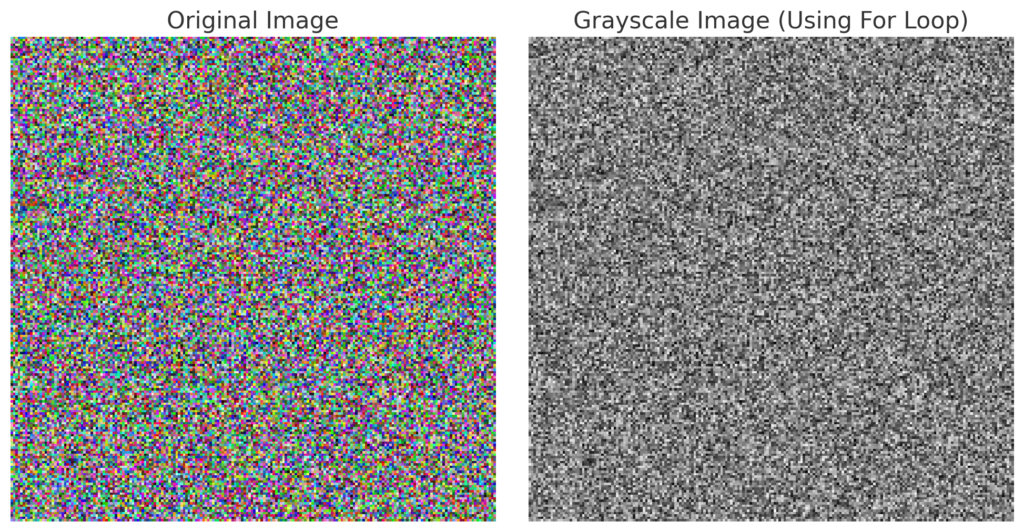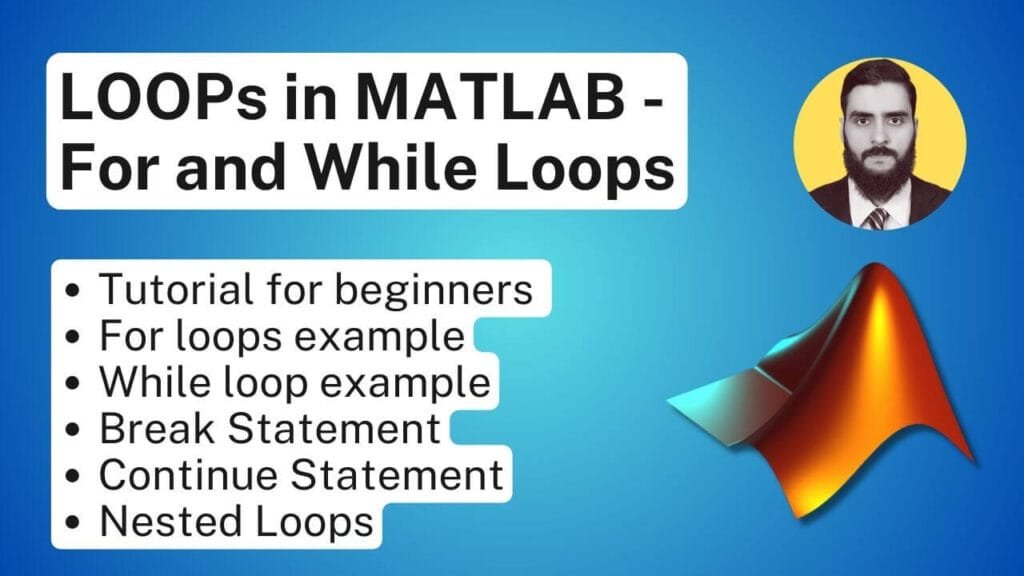For Loops in MATLAB
For loops stand as one of the foundational constructs of programming within MATLAB, playing a crucial role in automating repetitive tasks. Whether one is a data scientist analyzing complex datasets, an engineer developing simulations, or a student honing their programming skills, understanding for loops is vital. This iterative control structure allows users to execute a predefined set of statements a specific number of times, thus enhancing efficiency and reducing the likelihood of errors commonly associated with manual data manipulation.
The significance of for loops extends far beyond simple repetition; they enable users to handle arrays and matrices with elegance, making them indispensable for tasks involving data analysis, simulations, and algorithmic development. For instance, in data science, the ability to iterate through data structures enables analysts to apply statistical models, conduct simulations, and even implement machine learning algorithms effectively. Engineers using MATLAB leverage for loops to create iterative designs and optimize calculations, while small business owners can automate routine reporting tasks that would otherwise be labor-intensive.
Control flow structures play a vital role in every programming language, serving as the backbone of how we manage the flow of execution. In the world of basic MATLAB, two essential constructs— the for loop and while loop—allow programmers to run repetitive tasks efficiently and effectively, making code not just functional but dynamic and responsive!
Moreover, mastering for loops is instrumental not only for immediate applications but also for cultivating a deeper understanding of programming principles. As one becomes acquainted with iterations, they can better appreciate the relevance of concepts such as efficiency, code structure, and debugging.
In today’s data-driven world, the intersection of programming and data analysis continues to grow, making it imperative for professionals across various fields to be proficient in these essential techniques. Therefore, grasping the power of for loops in MATLAB presents a gateway to more advanced programming concepts and practical applications that can propel one’s career in any technical domain.

The for statement in MATLAB is a fundamental loop structure used to execute a block of code multiple times with a defined iteration range. It follows the syntax for index = start:increment:end, where index takes values from start to end with the specified increment. This loop is widely used for tasks like iterating over arrays, performing numerical computations, and automating repetitive operations in MATLAB scripts. Understanding the MATLAB for loop helps in optimizing code efficiency and reducing manual effort in data processing, simulations, and algorithm development.
Understanding For Loops in MATLAB
A ‘for loop’ in MATLAB is a fundamental programming construct that allows for the automation of repetitive tasks by executing a block of code a specified number of times. This iterative process is essential in programming as it enables the handling of a sequence of operations without the need to repeatedly write the same code. For instance, the syntax of a for loop typically involves defining the loop variable, the range of values it will take, and the body of code that will execute for each value in that range.
In MATLAB, the for loop is particularly valuable for iterating through arrays, matrices, or any collection of data. This makes it an indispensable tool for data analysis, where operations on large datasets often require repetitive calculations. Through the implementation of for loops, users can efficiently perform operations such as summing elements, applying functions, or modifying data structures without manual intervention, which streamlines coding and reduces the risk of errors.
In real-world applications on MATLAB, the significance of for loops extends beyond mere convenience. In engineering projects, for example, a MATLAB for loop can be used to simulate physical systems, run numerous scenarios, or optimize parameters based on iterative calculations. Similarly, in data analysis tasks, for loops are instrumental in automating the processing of data sets, allowing analysts to focus on deriving insights rather than getting bogged down in the mechanics of code execution.
The ability to master for loops in MATLAB is crucial for anyone looking to leverage programming for sophisticated data manipulation or engineering solutions. By grasping the core concept of this loop structure, users lay a robust foundation for tackling more advanced programming challenges that require iterative processing and automation.
Breaking Down Core Concepts of For Loops
For loops in MATLAB are fundamental constructs that allow for the execution of a sequence of statements repeatedly, based on a specified set of values. Understanding the mechanics of for loops is essential for efficient programming. At its core, a for loop generally consists of three components: the loop variable, the range of values over which to iterate, and the statements to execute during each iteration.
The syntax for a for loop can be illustrated as follows:
for index = startValue:endValue % statements to be executedend
In this syntax, the index is the loop control variable that takes on values from startValue to endValue. After each iteration, the index variable is automatically incremented. This iterative structure allows for repetitive tasks to be performed efficiently, eliminating the need for repetitive code blocks.
To provide a clearer understanding, consider the following example where a for loop is used to calculate the squares of numbers from 1 to 5:
for i = 1:5 square(i) = i^2 end
In this example, the loop iterates through the values 1 to 5. During each iteration, the square of the current value of i is computed and stored in the array square. This illustrates both the power and simplicity of using for loops in MATLAB for iterative computations.
Additionally, flowcharts can effectively visualize the loop’s execution process. They help depict how control flows through the loop, demonstrating key points such as initialization, condition checking, execution of statements, and incrementing the index variable. Mastering these core concepts equips programmers with the knowledge to implement for loops effectively in various programming scenarios.
Real-World Applications of For Loops in MATLAB
For loops are an essential construct in programming, particularly in MATLAB, where they serve as powerful tools for automating repetitive tasks. These loops can be utilized in a variety of real-world applications across multiple fields, particularly in programming projects, data science, and engineering calculations. Understanding how to implement for MATLAB loops effectively can greatly enhance efficiency and productivity in these areas.
One common use case for for loops in data manipulation is when working with large datasets. For instance, suppose a data scientist needs to normalize a dataset by scaling each value within a specified range. A for loop can iterate over each element of the data array, applying the normalization formula to each value accordingly. This approach not only streamlines the process but also minimizes the risk of errors that might occur when handling data manually.
In programming projects, for loops also find extensive applications in file processing. Consider an example where a developer needs to read multiple files containing sensor data. By employing a for loop, the code can systematically open each file, read its contents, and perform necessary computations such as averaging or summing sensor readings. This automation not only saves time but also ensures that the analysis remains consistent across all files.
Additionally, for loops are widely used in engineering calculations where repetitive numerical methods are required. For example, when solving differential equations numerically, an engineer might use a for MATLAB loop to implement the iterative methods of approximation. This makes it easier to refine solutions over several iterations, allowing for convergence toward an accurate result.
As demonstrated, for MATLAB loops play a crucial role in various practical applications. Their ability to simplify repetitive tasks and enable automation highlights their importance in programming and data analysis, making them invaluable tools in a programmer’s toolkit.
Beginner-Friendly Tutorial on for MATLAB Loop
To effectively utilize for MATLAB loops in MATLAB, the first step is setting up your MATLAB environment and getting acquaintance with Basic MATLAB uses. Ensure that you have a recent version of MATLAB installed on your computer. Opening MATLAB, you will encounter the Command Window, where you can execute commands. For MATLAB loops are an essential part of MATLAB programming, allowing repetitive tasks to be simplified through concise coding.
To begin, familiarize yourself with the basic syntax of a for loop, which is structured as follows:
for index = startValue:endValue
% Code to be executedendIn this example, the loop iterates from startValue to endValue, with index taking each integer value along the way. For instance, if you wanted to display the numbers from 1 to 5, you would write:
for i = 1:5
disp(i)
endThe code snippet above tells MATLAB to display the integer values sequentially within the specified range. It is important to distinguish that for MATLAB loops in MATLAB can also be nested. This means you can include one for loop inside another to perform more complex operations. Here’s a simple example:
for i = 1:3
for j = 1:3
fprintf('i = %d, j = %dn', i, j)
endendWhile coding, it’s crucial to be aware of common pitfalls. For instance, ensure that your loop index variable does not inadvertently match existing variable names in your workspace. This could lead to unexpected outcomes or errors. One expert tip is to always preallocate your arrays outside of the loop, which enhances performance and avoids growth during execution. Avoid direct manipulation of array sizes inside a for MATLAB loop whenever possible, as it can significantly slow down your code.
Basic Syntax of a for MATLAB Loop
A for MATLAB loop has the following structure:
for index = startValue:step:endValue
% Code to execute in each iteration
endindex: The loop variable that takes values from startValue to endValue.
startValue:step:endValue: Defines the range and step size for iteration.
The block inside for and end executes repeatedly for each value of index.
Example: Simple Iteration
Let’s start with a basic loop that prints numbers from 1 to 5.
for i = 1:5
fprintf('Iteration %d\n', i);
end
Output:
Iteration 1
Iteration 2
Iteration 3
Iteration 4
Iteration 5 Looping Over a Custom Range using For in MATLAB
You can modify the step size to control how the loop progresses.
for i = 1:2:10
disp(i);
end
Output:
1
3
5
7
9 Here, the loop runs from 1 to 10 with a step size of 2.
Iterating Over an Array using For in MATLAB
Instead of using numerical ranges, you can loop through elements of an array.
arr = [3, 7, 1, 9];
for value = arr
fprintf('Processing value: %d\n', value);
end
Output:
Processing value: 3
Processing value: 7
Processing value: 1
Processing value: 9 Nested for Loops in MATLAB (Useful for Matrices)
You can use nested loops to process matrices row by row or column by column.
A = [1 2 3; 4 5 6; 7 8 9];
for i = 1:size(A,1) % Loop through rows
for j = 1:size(A,2) % Loop through columns
fprintf('Element at (%d, %d): %d\n', i, j, A(i,j));
end
endThis loop iterates through each element in a 3×3 matrix
Visualizing Loops: Graphs and Plots
Loops are commonly used to generate sequences for plotting. You can generate simple 2D or more complex 3d plots in MATLAB. Example: Plotting a Mathematical Function in MATLAB
x = 0:0.1:10; % Generate values from 0 to 10 with step 0.1
y = zeros(size(x));
for i = 1:length(x)
y(i) = sin(x(i)); % Compute sine of each value
end
plot(x, y, 'b', 'LineWidth', 2);
xlabel('x values');
ylabel('sin(x)');
title('Plot of sin(x) using a for loop');
grid on;
This code uses a loop to compute sin(x) for multiple values and then plots the result.
Avoiding Common Mistakes and Improving Efficiency with for loops in MATLAB
Preallocating Arrays for Performance
Instead of dynamically expanding an array inside a loop, initialize it beforehand to speed up execution.
Inefficient Code:
for i = 1:1000
arr(i) = i^2; % Dynamically growing array (slow)
end
Optimized Code:
arr = zeros(1, 1000); % Preallocate memory
for i = 1:1000
arr(i) = i^2;
end
Using Vectorization Instead of Loops Where Possible
MATLAB is optimized for vectorized operations, which can often replace loops for better performance.
Instead of:
arr = zeros(1,1000);
for i = 1:1000
arr(i) = i^2;
end
Use:
arr = (1:1000).^2; % Faster and more concise
Handling Off-by-One Errors
Ensure that your loop indices match MATLAB’s 1-based indexing (unlike Python or C, where indexing starts at 0).
Examples of For Loop in MATLAB
Computing Factorials
n = 5;
fact = 1;
for i = 1:n
fact = fact * i;
end
fprintf('Factorial of %d is %d\n', n, fact);
Simulating a Dice Roll
numRolls = 10;
results = zeros(1, numRolls);
for i = 1:numRolls
results(i) = randi([1, 6]); % Random number between 1 and 6
end
disp('Dice roll results:');
disp(results);
Image Processing with for Loops in MATLAB
Images are represented as 3D matrices in MATLAB, with three color channels (Red, Green, and Blue). The goal is to convert a color image into grayscale manually using a for MATLAB loop.
First, load an image using the imread function and display it.
img = imread('peppers.png'); % Load a sample image
imshow(img);
title('Original Image');
Extract the height, width, and number of color channels.
[rows, cols, channels] = size(img);
Convert to Grayscale Using a Loop. A grayscale image is computed using the formula: Gray=0.2989×R+0.5870×G+0.1140×B. This formula mimics human perception by giving more weight to green.
grayImg = zeros(rows, cols); % Initialize grayscale image
for i = 1:rows
for j = 1:cols
% Extract RGB values of the current pixel
R = img(i, j, 1);
G = img(i, j, 2);
B = img(i, j, 3);
% Convert to grayscale using the weighted sum formula
grayImg(i, j) = 0.2989 * R + 0.5870 * G + 0.1140 * B;
end
end
% Convert to uint8 format for proper image display
grayImg = uint8(grayImg);
% Display the grayscale image
figure;
imshow(grayImg);
title('Grayscale Image Using For Loop');

Meet Ahsan – Certified Data Scientist with 5+ Years of Programming Expertise
👨💻 I’m Ahsan — a programmer, data scientist, and educator with over 5 years of hands-on experience in solving real-world problems using: MATLAB, Python, R, SQL, and Tableau
📚 With a Master’s in Engineering and a passion for teaching, I’ve helped countless students and researchers: Complete assignments and thesis coding parts, Understand complex programming concepts, Visualize and present data effectively
📺 I also run a growing YouTube channel — Algorithm Minds, where I share tutorials and walkthroughs to make programming easier and more accessible. I also offer freelance services on Fiverr and Upwork, helping clients with data analysis, coding tasks, and research projects.

Why Clients Trust Me – Real Stories, Real Results

“Ahsan completed the project sooner than expected and was even able to offer suggestions as to how to make the code that I asked for better, in order to more easily achieve my goals. He also offered me a complementary tutorial to walk me through what was done. He is knowledgeable about a range of languages, which I feel allowed him to translate what I needed well. The product I received was exactly what I wanted and more.” 🔗 Read this review on Fiverr
Katelynn B.
Watch MATLAB For MATLAB Loop Tutorial
In this in-depth tutorial, we explore the core concepts of loops like while and for in MATLAB from the mathworks, with practical examples for every beginner to expert level. Whether you’re looking to understand the structure of for MATLAB loops, while loops, or how to leverage the break and continue statements to control flow, this guide covers it all! What you’ll learn:
- For Loop Example: Learn how to use the for MATLAB loop to repeat a block of code a specific number of times.
- While Loop Example: Master the while loop for executing code as long as a condition is true.
- Break Statement: See how to exit loops early with the break statement when certain conditions are met.
- Continue Statement: Learn how to skip over parts of your loop with the continue statement.
- Nested Loops: Understand how to work with nested loops for more complex operations and data processing.

Navigating Challenges and Finding Solutions
When embarking on programming journeys, particularly in MATLAB, users may encounter various challenges while utilizing for MATLAB loops. Understanding these common pitfalls is crucial for efficient coding and effective problem solving.
One prevalent misconception is that for loops are always the most efficient solution for iterative processes. While for loops are powerful, they may not always offer optimal performance, especially with large data sets. In such cases, alternatives such as vectorization or employing MATLAB’s built-in functions can yield significant performance improvements. Embracing these alternatives can help streamline computations and reduce execution time, making the code not only faster but also more efficient.
Another challenge arises when the loop index is incorrectly utilized. Novice programmers often overwrite the loop variable inadvertently, leading to unexpected outcomes. To combat this issue, it is advisable to use descriptive variable names that signify the purpose and scope of the loop, thereby reducing the risk of errors. Additionally, ensuring that the loop index remains distinct from other variable names in the code can enhance clarity, thus minimizing confusion.
Debugging for loops can also pose difficulties. When encountering unexpected results, it is beneficial to include strategic breakpoints and utilize the debugging tools available in MATLAB. By examining each iteration’s output thoroughly, programmers can identify logical errors and rectify them effectively. Implementing verbose output statements that provide insights into loop progress can also be instrumental in tracking the flow of execution and identifying points of failure.
Learn MATLAB with Free Online Tutorials
Explore our MATLAB Online Tutorial, your ultimate guide to mastering MATLAB! his guide caters to both beginners and advanced users, covering everything from fundamental MATLAB concepts to more advanced topics.

In summary, mastering for loops in MATLAB involves recognizing common challenges, utilizing efficient coding practices, and actively engaging with debugging tools. By addressing these issues proactively, users can enhance their programming skills and successfully navigate the complexities inherent in loop control structures.
Other functions in MATLAB
MATLAB Ode45 function – Practical Tutorials
Ode45 is a widely utilized numerical solver designed for the effective resolution of ordinary differential equations (ODEs). It is a part of MATLAB’s ODE suite and is specifically tailored to handle problems where the solution requires the calculation of derivatives at multiple points. The significance of Ode45 stems from its implementation of the Runge-Kutta method, which offers a robust approach to approximating solutions with high accuracy.
MATLAB Diff function – Beginners Tutorials
MATLAB diff function is an essential tool utilized in the realms of data analysis and programming. Primarily, it calculates the differences between adjacent elements in an array, offering valuable insights into trends and behaviors of data sets. Through a blend of theoretical understanding and hands-on practical examples on MATLAB, this guide aspires to empower readers to utilize MATLAB’s diff effectively, transforming raw data into actionable insights.
MATLAB conv2 Function
Convolution is a mathematical operation that combines two functions to produce a third function, expressing how the shape of one function is modified by the other. Convolution is calculated using MATLAB conv2 function. This operation is particularly crucial in various fields such as image processing, signal analysis, and systems engineering. This function is specifically designed for two-dimensional convolution, making it preferable for tasks that involve images or other matrix-based data
fft2 in MATLAB
The FFT2 function in MATLAB is crucial for performing Fourier transforms on matrices, allowing practitioners to study and manipulate two-dimensional frequency components effectively. The Fast Fourier Transform (FFT) is an algorithm that computes the discrete Fourier transform (DFT) and its inverse efficiently. The DFT converts a sequence of equally spaced samples of a function into a sequence of coefficients of sinusoidal components, revealing the frequency spectrum of the sampled signal.
fzero MATLAB Function
The fzero in MATLAB is a powerful tool designed for finding the roots of nonlinear equations. This function plays a crucial role in various fields, including engineering, data science, and mathematical modeling. By utilizing fzero MATLAB, users can efficiently identify points where a given function equals zero, which is essential for solving problems that involve polynomial equations, differential equations, and optimization tasks.
MATLAB interp1 Function
The interp1 function in MATLAB serves as a fundamental tool for conducting one-dimensional interpolation on a set of data points. Interpolation is a statistical method that estimates values between two known values, allowing for more precise data analysis and management. By employing the interp1 function, users can obtain interpolated values at specified points, thus enabling a deeper analysis of datasets.
Key Takeaways and Practical Example
Throughout this comprehensive guide on mastering for loops in MATLAB, several crucial concepts and techniques have been discussed. For loops serve as a foundational programming structure, enabling users to execute a block of code multiple times with varying inputs. This repetitive capability is particularly efficient for computations that require iteration, such as processing arrays, iterating through data sets, or performing repeated calculations. One key takeaway is the understanding of loop syntax and structure, which includes initialization, condition checking, and iteration through defined variables.
Moreover, understanding scope and variable management within for loops is essential, as it impacts how data is handled throughout the iterations. Properly managing loop indices is critical to avoiding common pitfalls such as indexing errors or excessive iterations that lead to performance inefficiencies. Additionally, incorporating nested for loops increases flexibility, allowing for the manipulation of multidimensional data structures, which is a frequent requirement in advanced MATLAB applications.
To solidify this knowledge, we can examine a practical project. Consider implementing a simple algorithm that calculates the cumulative sum of an array. This project utilizes a for loop to iterate through each element of the array, summing values dynamically. The pseudo-code for this operation is as follows:
array = [2, 4, 6, 8, 10] cumulativeSum = 0 for i = 1:length(array) cumulativeSum = cumulativeSum + array(i) end
In this example, the for loop iterates over the elements of the array, updating the cumulative sum incrementally. This functional representation not only demonstrates the practical application of for loops but also reinforces the concepts presented earlier in the guide. By applying these programming principles to real-world scenarios, readers will develop a stronger grasp of how to effectively employ for loops in MATLAB.
For additional assistance, we invite you to explore our comprehensive blog article featuring 60 detailed MATLAB examples. These examples are designed to help you enhance your understanding of MATLAB’s functionalities and application in various fields. Each example is thoughtfully selected to cover a range of topics, from basic syntax and operations to more advanced programming techniques, ensuring that learners at all levels can benefit from them. Whether you’re just beginning or looking to refine your skills, this resource will provide valuable insights and practical knowledge.
Concluding Thoughts and Next Steps
Mastering the use of for loops in MATLAB is a significant milestone for both novice and experienced programmers. These structures empower users to handle repetitions efficiently, enhancing code clarity and functionality. By understanding and utilizing for loops, individuals can optimize their workflows, automate repetitive tasks, and ultimately produce more robust and scalable algorithms. The importance of incorporating these looping constructs into one’s programming repertoire cannot be overstated, as they are foundational elements in various applications ranging from simple data analysis to complex simulations.
As you reflect on the concepts discussed throughout this guide, consider how you can apply these techniques in your own projects. The ability to iterate through arrays, perform repeated calculations, or manipulate data sets is invaluable, particularly in fields such as engineering, data science, and computational research. By implementing for loops in MATLAB, you stand to enhance your productivity and refine your analytical capabilities.
Furthermore, the learning process does not end here. To deepen your understanding and proficiency, exploring additional resources such as online tutorials, MATLAB documentation, and community forums can be tremendously beneficial. As you continue your journey, do not hesitate to seek personalized support if needed. There are many platforms and services available that offer targeted assistance, including mentoring or specialized courses. Engaging with experts can provide insights tailored to your specific needs, ultimately accelerating your mastery of MATLAB.
In conclusion, persistent practice and application of for loops will lead to greater command over MATLAB programming, enabling you to tackle increasingly complex challenges with confidence. Embrace the opportunity to explore, and reach out for support to further your development on this path.
Frequently Asked Questions for MATLAB
For loops are a foundational concept in MATLAB programming, yet many users encounter challenges in their usage. Addressing common questions can elevate the understanding of this concept significantly. One frequent inquiry is regarding the syntax of for loops in MATLAB. The basic structure follows the format: for index = start_value:end_value, where index is the loop control variable, and start_value and end_value define the range of the loop. Proper initialization and termination of the loop are crucial for optimal execution.
Another common question pertains to nested for loops. When utilizing nested for loops, it’s important to ensure the inner loop completes its full range for each iteration of the outer loop. The proper organization and indentation of nested loops enhance readability, making code easier to debug. An example of this structure could look like: for i=1:n followed by for j=1:m within its block.
Moreover, users sometimes face issues regarding performance when using for loops with large datasets. In such cases, it may be advisable to explore vectorization—MATLAB’s preferred method for data processing, which typically provides better performance outcomes than iterative approaches. When faced with looping over arrays or matrices, users can leverage built-in functions that eliminate the need for explicit loops.
Additionally, some users may wonder about an appropriate approach when a loop becomes complex. In such scenarios, it is prudent to encapsulate loop logic into functions. Writing modular code not only simplifies troubleshooting but also improves code maintainability and reusability. Understanding these aspects of for loops in MATLAB improves programming proficiency and enhances overall efficiency.